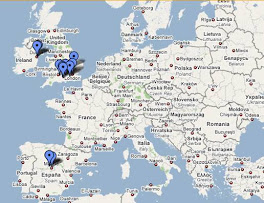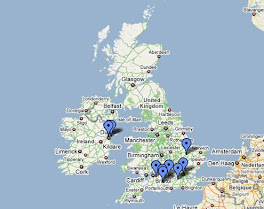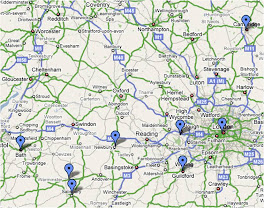Reluctantly waking up after a crazy night of partying, Bill and I eventually met at the train station to catch an early train from Guildford to Bath. Switching trains in Reading, I managed to catch a few extra minutes of sleep on the second leg of our journey. Upon arriving in Bath, Bill and I were instantly enchanted by the quaintness of this ancient town. To brush away a few cobwebs to anyone back home who is a little rusty on Roman history, the Romans first conquered Britain in 43 AD. When the Romans settled in Bath soon after and discovered natural hot springs in the small city. Intrigued, the Romans built a temple around the springs and named the site Aquae Sulis in honor of the goddess Minerva (the Roman version of Athena). As we walked through the ancient ruins, I noticed that the architecture of the Roman Baths was quite advanced for that early point in history. The hot springs, which still bubble today, were enclosed in a small pool with plumbing connecting the water source to the other pools in the temple. The floors of the temple were built on stone pillars, which allowed steam from the hot water to pass underneath the floors to keep them warm. (I guess the Romans hated to walk on cold floors when passing from one area of the temple to the other.) The Romans believed the baths had healing properties, and the sick would visit the temple to alleviate illness. Other Romans would come to Bath to pay homage to the goddess Minerva. Archaeologists unearthed hundreds of notes to the goddess that were pounded into small sheets of metal. Most of these notes were requests for vengeance against thieves and evil-doers. Unfortunately for the Romans, their reign in Britain did not last forever and possession of the baths changed hands many times throughout history. As new civilizations occupied the once-Roman city, the conquerers tore down, remodeled, and added their own touch to the Roman temple. Today, the only Roman part of the temple that remains are the swimming baths and building foundation. Other statues, walls, and walkways that are present today were created at later points in history by other nationalities. Regardless, the temple still felt as if we were stepping back into Roman times.
Spending most of the morning at the baths, Bill and I couldn't stop from marveling at the beauty of the ruins. The water was an emerald shade of green (due to the algae in the pools), and the spring bubbled with the perfect temperature of bathwater. Finishing our audio tour, we headed back to the visitor's center where they gave us each a free glass of fresh spring water to sample. Expecting a cool refreshing glass of spring water, I was surprised to taste a warm, mineral-laced gulp of H2O. As our British friend Mathew described it, "The mineral water is supposed to be incredibly healthy, but it actually just tastes like shit."
Moving from the Roman baths, we headed through the city in search of a park bench for a relaxed lunch in the surprisingly warm sunshine. Seemingly deserted when we went into the Roman Bath Museum, I was surprised to see the town square packed with people in the afternoon. Home-grown musicians and bands lined the sidewalks in hopes of gaining a few pounds from passers-by their musical performances. Artists and merchants set up tents and booths to sell paintings, flowers, produce, and cloth. Bill and I laughed when we saw three people dressed as Native Americans giving a concert in the square. Their display was pretty elaborate with tee-pees and heavy-duty sound equipment. I can remember turning to Bill and saying, "Now that's one sight that I never thought I would see in Europe!" We also saw a mime covered from head to toe in silver clothing and facepaint. He was standing on a pedestal that stated:
If you:
Like It, £1
Love It, £2
Hate It, £50
After a bit of searching, we managed to find a bench near the Bath Abbey where a percussionist was giving a solo concert on vibraphone. (As a drummer myself, I was thrilled by the lunchtime entertainment!) Munching on a tuna salad sandwich, I thoroughly enjoyed the opportunity to relax and rest my feet.
Our next stop was the Bath Fashion Museum. Formerly known as the Costume Museum, this collection of clothes throughout the ages was interesting to see and not too expensive since we managed to pick up a combo admission ticket at the Roman Baths. The Fashion Museum was pretty neat with clothing displays from every decade. They even had a small changing area where women could try fitting into corsets and crinolines. (For those of you who are of the male gender, click here for a picture of these centuries-old female undergarments.) Squeezing myself into the ridiculously tight corset and trying to breathe as Bill laced the rib-crunching piece of fabric, I suddenly knew why women's underwear quickly evolved into the cotton Hanes-Her-Way version that we know today. My overall impression of the museum was alright. The exhibits were small and slightly haphazardly organized, but a few of their dresses were positively beautiful. As a former pageant girl, I've learned to appreciate the beauty of a gorgeous evening gown. ;)
Upon leaving the Fashion Museum, Bill and I decided to finish up our museum visits with a tour of the "Bath at Work Museum". In the early 1900s, Bath had a booming spurt of industry. It had a huge limestone-mining industry, was one of the first cities to produce and bottle ginger ale, and later supported tourism of the Roman Baths. The Bath at Work Museum was a cute little place housed in the shop of a former general store owner that solde goods, picked locks, bottled soda drinks, and made steel fittings from sand molds. In a nutshell, this guy did pretty much anything and everything to satisfy his customers. The museum was neat for catching a glimpse of the early 1900s during the Industrial Revolution, but by the end, I was getting a little burnt out on audio tours.
By midafternoon, Bill and I had seen almost every historical site in Bath: the Roman Baths, Fashion Museum, Bath at Work Museum, and the Bath Abbey (which I failed to write about, but is nearly as spectacular as Westminster Abbey). Seeing that the weather was positively gorgeous, we found a large park and parked ourselves on a soft patch of grass for an hour or so. Keeping up a bit of small talk, I was thankful for the short "breather" during a day of continuous touring. Once the ground started to feel a little hard, we headed back downtown to find a pub for dinner. Eventually, we found a cute pub, grabbed a quick bite to eat, and walked to our final destination of the day: the Thermae Spa.
The Thermae Spa is probably one of the biggest tourist traps in Bath. It's a modern full-service spa equipped with two swimming pools and multiple steam rooms. Their claim to fame comes from the fact that they pump treated water from the hot springs to fill their swimming pools. So in a sense, tourists can swim in the "springs" for $20/hour. Before buying a 2-hour swimming pass, I completely knew that this was a tourist trap alternative to swimming in the Roman Baths. However, Bill was determined to have a long relaxing bath in authentic Bath water. I can't fault him too much for standing his ground. The spa was incredibly relaxing and the water was fabulously warm. We spent part of our time on the roof-top pool where we could watch the sunset over the famous historic city. All in all, a few hours of quality relaxation may have been worth $40.
Heading home with wet hair, wrinked fingers, and jello-like muscles, Bill and I agreed that Bath was probably the quaintest city in England. Though small, it was beautiful, historic, and a wonderful day trip!











No comments:
Post a Comment